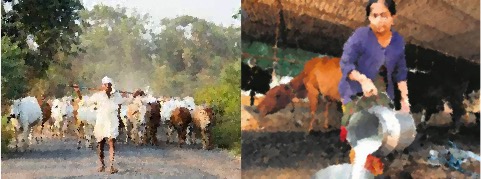Dairy and poultry need a proper ecosystem comprising reliable animal feed supplies and FPOs with market linkages
The global animal feed market is undergoing marked changes that are likely to accelerate this decade. The pattern of global consumption is evolving towards higher share of animal products in diets. So, higher quantities of crops will be used as feed.
Maize (corn) and protein meal (oilseed extractions) will remain the most important feed commodities and will constitute 60 per cent of total feed use by 2030, according to OECD-FAO. Feed demand for maize is set to grow by 1.4 per cent per annum, slightly faster than projected 1.2 per cent growth for protein meals.
Importantly, worldwide meat consumption is shifting towards poultry, primarily reflecting lower poultry prices in low-income developing countries where demand is price elastic. As incomes recover, demand will recover too. By 2030, poultry meat will represent 41 per cent of all protein from meat sources as consumers are attracted to lower price, product consistency and higher protein/lower fat content.
There will be challenges, though, such as disease outbreaks, sanitary restrictions and trade policies that will affect the evolution and dynamics of the world meat market. Poultry scores in meeting these challenges simply because poultry can respond more quickly to market signals due to shorter production cycle as compared with ruminants.
Poultry is amenable to faster improvement in genetics, animal health and feeding practices. As poultry expands, greenhouse gas emissions will slow. Indeed, in the US, young cattle are given ‘potty-training’ in facilities known as ‘Moo-Loo’ so as to restrict the spread of greenhouse gases.
These trends are sure to find an echo in India, world’s largest producer of milk and third largest in egg production. The annual average growth rate of animal husbandry, diary and fisheries in five years till 2020 was 8.6 per cent. According to Livestock Census 2020, total milch cattle population was up by 10.5 per cent to 74.6 million in 2019.
Rising production
Projections show that by 2022-23, milk production will expand to 235 million tonnes (from 198 mt in 2019-20) and egg production to 136 billion (from 114 billion in 2019-20). So, strong growth in dairy production combined with feed intensification will result in a 2.4 per cent feed demand growth next 10 years. At the same time, protein meal demand is set to rise by 3 per cent per annum next 10 years as India moves towards compound feed-based livestock production.
This is the backdrop in which the industry must examine and evolve a sustainable animal feed market. But such a market will have to be part of ‘Sustainable Animal Agriculture Ecosystem’. The industry has inherited a legacy ecosystem that does not recognise sustainability and needs to evolve to face looming changes. For the purpose, review of technologies, services, standards and regulations is necessary.
For the animal feed manufacturers, there are challenges in sourcing raw material for feed including land constraint, water shortage, climate change, low crop yields, lack of tech infusion and but not the least, policy constraint. These need to be overcome.
Stakeholders in animal agriculture face challenges. Uncertainty of raw material/feed availability, feed price volatility, demand fluctuation, policy environment and gradual inroads made by plant protein are some of the issues the industry will have to tackle.
Of course, there are solutions the industry must be ready to embrace. For assured availability and access to raw material, contract farming is the way forward. Establishing backward linkages especially with FPOs (Farmer Producer Organizations) will provide price stability and assured access with scale economies.
Feed price volatility often hurts the bottomline of manufacturers. Hedging in commodity exchanges through the derivatives route is a time-tested method of price risk management. Delivery based Forward contracts can be explored.
While pervasive protein deficiency in India is sure to boost protein consumption as incomes rise, perhaps the biggest challenge to animal protein will come from the emerging plant protein segment. The industry must recognise that animal protein — whether milk, meat, poultry or eggs — is far more expensive than vegetable protein as the author’s research on comparative protein cost shows. So, the big question is whether animal protein can compete with plant protein cost-to-cost, especially in a price-sensitive country such as ours.
Finally, the animal agriculture-based industry should be clear about where it wants to be in the next 10 years.
Research is therefore a priority to study the market and come up with demand projections, strategy to ensure higher yields per milch animal, ways to promote animal health and nutrition, estimation of the number of layers and broilers needed, feed demand, as well as vaccine requirement. Upgrading skills to keep up with global trends, setting up of adequate processing capacity and investment deserve special attention as the industry has potential to attract foreign direct investment.
Source : Hindu business Line Oct 12th 2021: Excerpts of speech delivered at the recent CLFMA of India national symposium in Hyderabad. G Chandrashekhar is a policy commentator and agribusiness specialist. Views are personal



























